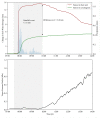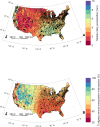Measuring turfgrass canopy interception and throughfall using co-located pluviometers
- PMID: 36054190
- PMCID: PMC9439196
- DOI: 10.1371/journal.pone.0271236
Measuring turfgrass canopy interception and throughfall using co-located pluviometers
Abstract
Turfgrass management relies on frequent watering events from natural precipitation or irrigation. However, most irrigation scheduling strategies in turfgrass ignore the magnitude of canopy interception. Interception is the process by which precipitation or irrigation water is intercepted by and evaporated from plant canopies or plant residue. The objective of this study was to quantify the magnitude of precipitation interception and throughfall in 'Meyer' zoysiagrass (Zoysia japonica L.) and '007' creeping bentgrass (Agrostis stolonifera L.). We used a new method consisting of co-located pluviometers with and without circular turfgrass patches to measure interception and throughfall. The resulting dataset includes 15 storms and 25 individual rainfall events ranging in precipitation totals from 0.3 mm to 42.4 mm throughout the research study. Throughfall amount resulted in a strong (r = 0.98) positive linear relationship with precipitation totals. On average, zoysiagrass and creeping bentgrass canopies intercepted a minimum of 4.4 mm before throughfall occurred. This indicates that, on average, no precipitation reaches the soil surface for precipitation events <4.4 mm. After the point of throughfall, 16% of each additional millimeter of precipitation or irrigation is lost due to interception. Nearly, 45% of the area of the contiguous U.S. could result in >50% of the annual precipitation being intercepted by canopies of zoysiagrass and bentgrass. This study provides detailed insights to understanding the interception dynamics in turfgrass and highlights the inefficient nature of small precipitation and irrigation events in turfgrass systems.
Conflict of interest statement
The authors have declared that no competing interests exist.
Figures





References
-
- Morris KE. National turfgrass research initiative. National Turfgrass Federation, Inc., and National Turfgrass Evaluation Program, Beltsville. 2003.
-
- Throssell CS, Lyman GT, Johnson ME, Stacey GA, Brown CD, Golf Course Environmental Profile Measures Water Use, source, cost, quality, management and conservation strategies. Applied Turfgrass Science. 2009;6(1):1–20.
-
- Beard JB, Turfgrass root basics. TURFAX. 2001;9(3), 4–5.
-
- Burgy RH, Pomeroy CR, Interception losses in grassy vegetation. Transactions, American Geophysical Union. 1958;39(6):1095.
-
- Ochsner TE, Rain or shine: An introduction to soil physical properties and processes. 2022; p. 94–99. Published by Oklahoma State University Libraries under the Creative Commons Attribution 4.0 International License. doi: 10.17605/OSF.IO/Z4RBT - DOI
Publication types
MeSH terms
Substances
LinkOut - more resources
Full Text Sources

